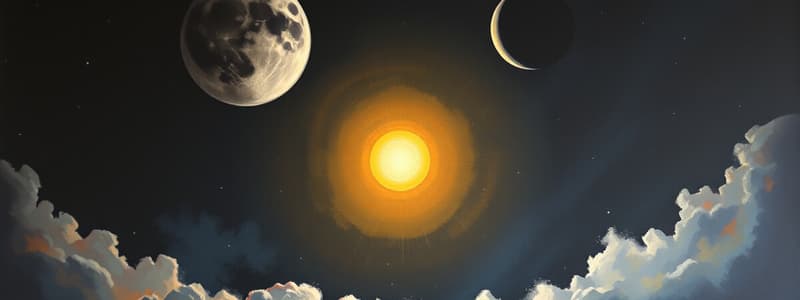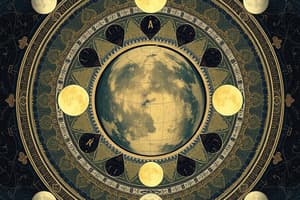Podcast
Questions and Answers
What is the umbra?
What is the umbra?
The central, darker part of a shadow where light is totally blocked.
What is the penumbra?
What is the penumbra?
The lighter part of a shadow where light is partly blocked.
What is a solar eclipse?
What is a solar eclipse?
An occurrence during which the Moon's shadow appears on Earth's surface.
What is a lunar eclipse?
What is a lunar eclipse?
What are tides?
What are tides?
What is an orbit?
What is an orbit?
What is revolution?
What is revolution?
What is rotation?
What is rotation?
What is a solstice?
What is a solstice?
What is an equinox?
What is an equinox?
What is a phase of the Moon?
What is a phase of the Moon?
What are waxing phases?
What are waxing phases?
What are waning phases?
What are waning phases?
Describe two types of Earth's motion.
Describe two types of Earth's motion.
How does the Sun compare in size and mass to Earth?
How does the Sun compare in size and mass to Earth?
Why does Earth stay in orbit around the Sun?
Why does Earth stay in orbit around the Sun?
List three facts about Earth's rotation axis.
List three facts about Earth's rotation axis.
Why do different parts of Earth's surface receive different amounts of energy?
Why do different parts of Earth's surface receive different amounts of energy?
What two factors cause the seasons to change?
What two factors cause the seasons to change?
List four facts about the Northern Hemisphere when the north end of Earth points at the Sun.
List four facts about the Northern Hemisphere when the north end of Earth points at the Sun.
List four facts about the Northern Hemisphere when the north end of Earth points away from the Sun.
List four facts about the Northern Hemisphere when the north end of Earth points away from the Sun.
Compare and contrast solstice and equinox.
Compare and contrast solstice and equinox.
Describe the Moon and compare its size to Earth.
Describe the Moon and compare its size to Earth.
Compare and contrast the rotation and revolution of the Moon.
Compare and contrast the rotation and revolution of the Moon.
What produces the Moon's revolution around Earth?
What produces the Moon's revolution around Earth?
Why do we always see the same side of the Moon?
Why do we always see the same side of the Moon?
How much of the Moon is always lit up by the Sun?
How much of the Moon is always lit up by the Sun?
What is a lunar cycle and how long is it?
What is a lunar cycle and how long is it?
Describe the waxing phase.
Describe the waxing phase.
Describe the waning phase.
Describe the waning phase.
Compare and contrast the two parts of a shadow.
Compare and contrast the two parts of a shadow.
What casts a shadow on what during a solar eclipse?
What casts a shadow on what during a solar eclipse?
Compare and contrast a total and a partial solar eclipse.
Compare and contrast a total and a partial solar eclipse.
Why don't we see a solar eclipse every month?
Why don't we see a solar eclipse every month?
What casts a shadow on what during a lunar eclipse?
What casts a shadow on what during a lunar eclipse?
Compare and contrast a total and a partial lunar eclipse.
Compare and contrast a total and a partial lunar eclipse.
Why don't we see a lunar eclipse every month?
Why don't we see a lunar eclipse every month?
Compare and contrast solar and lunar eclipses.
Compare and contrast solar and lunar eclipses.
What is the primary cause of tides?
What is the primary cause of tides?
What causes the tidal bulge?
What causes the tidal bulge?
Where do high tides occur?
Where do high tides occur?
Contrast the Sun's effect on tides to the Moon's effect.
Contrast the Sun's effect on tides to the Moon's effect.
Explain when spring tides occur and why.
Explain when spring tides occur and why.
Explain when neap tides occur and why.
Explain when neap tides occur and why.
Flashcards are hidden until you start studying
Study Notes
Umbra and Penumbra
- Umbra: The darkest part of a shadow where light is completely blocked.
- Penumbra: The lighter region of a shadow where light is partially blocked.
Eclipses
- Solar Eclipse: Occurs when the Moon's shadow falls on Earth during a new moon phase.
- Lunar Eclipse: Happens when the Moon moves into Earth’s shadow during a full moon phase.
Tides
- Tide Definition: The regular rise and fall of ocean levels caused by gravitational forces between Earth, the Moon, and the Sun.
- High and Low Tides: High tides occur at tidal bulges, while low tides occur between them.
Earth's Motion
- Orbit: The path one object follows around another.
- Revolution: Earth's movement around the Sun, taking about 365.24 days.
- Rotation: Earth's spin on its axis, completing every 24 hours.
Earth’s Axis and Seasons
- Tilted Axis: Earth’s rotation axis is tilted, which affects seasonal changes.
- Solstice: Occurs when the tilt is either toward or away from the Sun, affecting daylight duration.
- Equinox: Happens when the axis is neither tilted toward nor away from the Sun, resulting in equal daylight and nighttime hours.
Moon Phases and Characteristics
- Lunar Cycle: The sequence of lunar phases, taking approximately 29.5 days.
- Waxing Phase: The right side of the Moon becomes increasingly illuminated.
- Waning Phase: The left side of the Moon becomes less illuminated.
Shadow Types
- Shadow Composition: A shadow consists of two parts, the umbra and the penumbra, affected by the light source distance.
Solar and Lunar Eclipses Comparison
- Total vs Partial Solar Eclipse: A total eclipse is viewed within the umbra; a partial one within the penumbra.
- Eclipse Frequency: Solar eclipses do not happen monthly due to the Moon's tilted orbit. Lunar eclipses are also infrequent because of orbital inclinations.
Tides Mechanics
- Tidal Bulge: Caused by varying gravitational strength of the Moon on Earth; results in two bulges creating high tides.
- Sun's Effect on Tides: The Sun also influences tides, but its effect is less pronounced than the Moon's due to its greater distance.
Spring and Neap Tides
- Spring Tides: Occur when the Earth, Moon, and Sun align (new/full moons), producing the highest and lowest tide levels.
- Neap Tides: Happen when the Moon and Sun form a right angle with Earth, resulting in reduced tidal ranges.
Studying That Suits You
Use AI to generate personalized quizzes and flashcards to suit your learning preferences.




